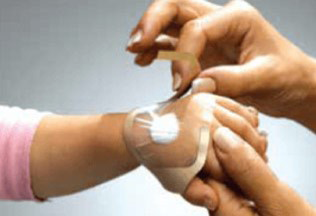Your child’s injury has been assessed tonight to ensure they are safe and comfortable. While the wound will likely need to be surgically repaired, it does not have to be done tonight. This means you can take your child home tonight but our clinicians will need to review the wound again tomorrow and decide the best way to repair it.
Sometimes when wounds are reviewed the following day, in consultation with the plastic surgery team, we find that it might not need the level of repair that was originally considered. This means that your child’s wound or injury can be managed in a less invasive way.
We will ensure that you have all the medication you need before you leave Emergency so that your child will be comfortable until they return for their procedure.
When to return to Emergency
Please return to the triage desk at 11.30am unless you are called in the morning and given a different time.
We will do our best to ensure that your child’s procedure occurs with a minimal wait time, however their procedure may be delayed if there are more urgent cases.
Before returning to Emergency
Eating and drinking
Your child can eat until 7.30am.
Your child can drink clear fluids (e.g. water, juice) until 10.30am.
Applying numbing cream
Apply numbing (local anaesthetic) cream to your child’s arms 45 minutes before returning to Emergency. This will numb the surface of the skin and reduce the discomfort and distress that your child may experience by having a drip placed in their arm.
It is common for the skin under the numbing cream to become raised, red, and sometimes itchy – this indicates that the cream is working.
| Step 1: Ensure skin is clean and dry. |
Step 2: Apply anaesthetic cream to the skin to form a mound, around 1cm across the area. This should be done on the back of both hands and on the inside of the elbows to allow for more options.
|
Step 3: Apply occlusive dressing over the area with cream
|
Step 4: Remove outside cardboard edge of dressing
|
Sedation during the procedure
Sedation may be given to your child to ensure they are comfortable throughout their procedure.
This involves giving your child a small amount of medication to make them feel relaxed and ease their pain while we complete their procedure. It is not a general anaesthetic, so your child might retain some awareness of what is happening around them and they will continue to breathe on their own.
Prior to the procedure, you child’s doctor will talk to you in more detail about the medication they will use for the sedation.
Contact us
Emergency Department
Queensland Children’s Hospital
Level 1, 501 Stanley Street, South Brisbane QLD 4101
In an emergency, always call 000.
If it’s not an emergency but you have any concerns, contact 13 Health (13 43 2584). Qualified staff will give you advice on who to talk to and how quickly you should do it. You can phone 24 hours a day, seven days a week.
Developed by the Emergency Department, Queensland Children’s Hospital. We acknowledge the input of consumers and carers.
Resource No: FS393. Developed by the Emergency Department. Updated: December 2023.
Disclaimer: This information has been produced by healthcare professionals as a guideline only and is intended to support, not replace, discussion with your child’s doctor or healthcare professionals. Information is updated regularly, so please check you are referring to the most recent version. Seek medical advice, as appropriate, for concerns regarding your child’s health.


